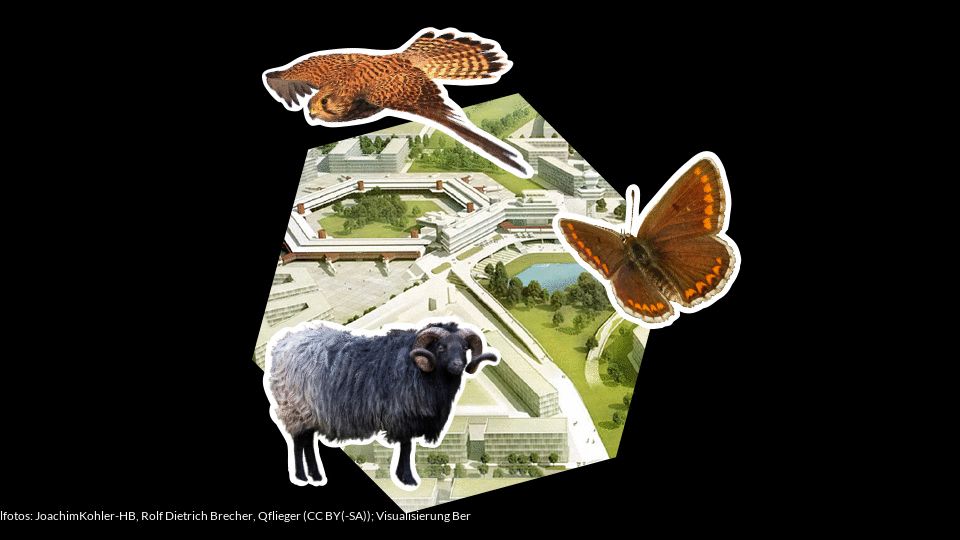Our society is becoming increasingly aware of the importance of biodiversity for humans and nature. For the central part “Campus West” of the urban development project Berlin TXL – The Urban Tech Republic, Tegel Projekt GmbH has had its own biodiversity strategy drawn up. Around the buildings of the former airport, which are highly dominated by the concrete apron areas, the foundations are being laid for new, native animal and plant species to settle – from the meadow sage to the crested lark. The Campus West biodiversity strategy will have an impact on the entire research and industrial park Berlin TXL – The Urban Tech Republic. The most important measures in terms of the Biodiversity Strategy for Campus West include:
- Increasing the amount of green space in the immediate vicinity of the central airport buildings while observing and complying with the framework conditions for the “Berlin-Tegel Airport” monument
- Local production of food and seeds
- Nesting aids, bird-friendly glazing and nature-friendly lighting
- Sustainable timber (hybrid) construction
- Public information events and training on biodiversity & sustainability support for users
The biodiversity strategy was developed by the planning offices Drees & Sommer and bgmr Landschaftsarchitekten on behalf of the State of Berlin, represented by Tegel Projekt GmbH. The site of the new Campus West comprises the most densely developed part of the old airport, where special requirements of monument protection must be observed. The terminals and the former tower form the heart of the Urban Tech Republic in their new functions. The Basecamp with offices, coworking spaces for start-ups, a congress centre and the new premises of the Berlin University of Applied Sciences (Beuth Hochschule until September 2021) will be built there.
Four key issues for more biodiversity
The four key themes of the Biodiversity Strategy Campus West are based on the thematic fields of the Berlin Biodiversity Strategy:
- Making grey infrastructure greener
Greened traffic areas, roofs and façades create new habitats for animals and plants in the middle of cities and connect the spatial demands of people and nature. Central new green spaces will be the Loop Park and the green joints to the surrounding areas.
- City as a metabolic process
By unsealing, water is used on site and the urban climate is improved, especially in summer. Green spaces can be used to grow young plants and obtain seeds that are best adapted to the location. Roof gardens are suitable for the local production of food.
- Well-Being for people and nature
The species-rich greening should be adapted to the needs of native animal species. Nesting aids on buildings can, for example, prepare the settlement of bats and kestrels. Nature-friendly lighting protects above all the insects that are important for biodiversity.
- Responsibility in the Anthropocene
Since industrialisation, humans have fundamentally changed the earth, which is why they must align their economic activities with their responsibility for nature. In the Urban Tech Republic research and industrial park there are many points of contact – from advising the companies located there on sustainable supply chains to raising visitors’ awareness of biodiversity.
Synergies with the innovation location Berlin TXL
Additional synergies to the profile of Berlin TXL – The Urban Tech Republic as a location for sustainable innovations were identified for two topics:
- Bio-based research and teaching
Nature is the greatest innovator: The Berlin University of Applied Sciences offers degree programmes that take nature as their model. The sustainable solutions that nature has developed are also to be brought to the attention of the public.
- Building with natural and recyclable materials
Renovation and new construction offer opportunities in Campus West for the use of materials from renewable raw materials, sustainable production, recycled materials and recyclable composition. This minimises the extraction of new raw materials.
Award for sustainable building
With its biodiversity strategy, Campus West is taking on a pioneering role in urban town planning. In intensively used and highly sealed spaces, the demands of nature and humans collide. For a long time, attempts were made to solve this conflict through compensatory areas. New concepts, however, are discovering the value of urban spaces for the expansion of biodiversity. Targeted planning creates habitats for animals and plants and a new coexistence between humans and nature. Enjoyment of nature in combination with an improved microclimate also increases the well-being of human users. The pioneering role of Campus West is expressed by an award from the German Sustainable Building Council (DGNB). As a commercial quarter, Campus West was already awarded a preliminary certificate of the highest level “Platinum” in 2016.
